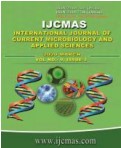


 National Academy of Agricultural Sciences (NAAS)
National Academy of Agricultural Sciences (NAAS)

|
PRINT ISSN : 2319-7692
Online ISSN : 2319-7706 Issues : 12 per year Publisher : Excellent Publishers Email : editorijcmas@gmail.com / submit@ijcmas.com Editor-in-chief: Dr.M.Prakash Index Copernicus ICV 2018: 95.39 NAAS RATING 2020: 5.38 |
The study was carried out with an objective to assess the technology of enhancement of fish production by incorporating Minor Carp Sps. in Composite fish culture system. The experiment was conducted for ten months from June, 2018 to March, 2019 in nine earthen ponds of 0.3 ha (3 no. ponds), 0.4 ha (3 no. ponds) & 0.5 ha (3 no. ponds) of three different villages of Angul district. In the first phase Pre-stocking pond preparation methods are followed i.e. removal of predatory and weed fishes by bleaching powder (10 mg/l chlorine) and then basal fertilization (3 tonn cow dung and 30 kg single super phosphate / ha) were carried out before stocking of fingerlings (Jena et al., 2005). Three different species combinations were taken i.e. Control (T1) (Catla : Rohu :Mrigal) at the ratio of 40:30:30 @ 10000 no. /ha and culture for 10 months. In Recommended practice incorporation of Puntius sarana @ 10 % or 1000 no./ha in the Major Carp system i.e. (Catla :Rohu :Mrigal: Puntius) at the ratio of 40:30:30:10 @ 10000 no. / ha and culture for 6 months (T2). Incorporation of Puntius sarana @ 20 % or 2000 no./ha in the Major Carp system i.e. (Catla :Rohu :Mrigal) at the ratio of 40:30:30:20 @ 10000 no. / ha and culture for 6 months (T3). In farmers practice they usually stocked mixed seeds (35-40) mm size of Indian Major Carps and not adopting the scientific Pisciculture practices. In recommended practice the farmers were provided with Complete technical support of raising of the minor Carp Species i.e. Puntius sarana through proper post stocking management measures to utilize the total food space available in the pond environment. Health management aspects were assessed by periodic sampling. Fish yield was recorded after harvesting. About 2.5-3 meter water depth was maintained throughout the study period. Water samples were collected from the ponds at 15-day intervals between 07:00 and 08:00 h and analyzed for important parameters were measured following standard methods (APHA, 2014). Then the data like fish weight (gm), fish yield (Quintal/hectar), Survivability percentage, average net return and B: C was recorded and analysed using statistical tools like Average mean value and percentage. From the results of the analysis it is found out that mean weight gain of Puntius sarana / Olive barb were higher in T3 compared to T1 and T2. Daily weight gain and net fish yield in T2 and T3 were also higher than T1. In the present study stocking of Puntius sarana & IMC fingerlings of recommended size and density along with adopting the post stocking management schedules resulting the increase in Avg. weight of Olive barb upto 315 gm where as the weight of IMC remains 420 gm during harvesting . Net profit of Rs. 1,67,363 was obtained from this technology with benefit: cost (B: C) ratio of 2.75 against Rs. 76,197 and 1.83 respectively from Control (T1) due to more fish growth & production. Similarly 56.55 % increase in fish yield was also observed in this technology (26.3 q/ha) against Control (16.8 q/ha).
 |
 |
 |
 |
 |